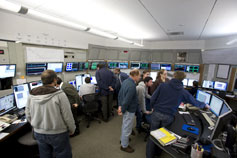
Handy Links
SLAC News Center
SLAC Today
- Subscribe
- Archives: Feb 2006-May 20, 2011
- Archives: May 23, 2011 and later
- Submit Feedback or Story Ideas
- About SLAC Today
SLAC News
Lab News
- Interactions
- Lightsources.org
- ILC NewsLine
- Int'l Science Grid This Week
- Fermilab Today
- Berkeley Lab News
- @brookhaven TODAY
- DOE Pulse
- CERN Courier
- DESY inForm
- US / LHC
SLAC Links
- Emergency
- Safety
- Policy Repository
- Site Entry Form

- Site Maps
- M & O Review
- Computing Status & Calendar
- SLAC Colloquium
- SLACspeak
- SLACspace
- SLAC Logo
- Café Menu
- Flea Market
- Web E-mail
- Marguerite Shuttle
- Discount Commuter Passes
-
Award Reporting Form
- SPIRES
- SciDoc
- Activity Groups
- Library
Stanford
Around the Bay
First Electrons Stream Through the LCLS
On Saturday afternoon, a series of electron beams zipped down the full length of the Linac Coherent Light Source for the first time. In an exciting round of first-ever tests, bunches of electrons traveling very close to the speed of light traveled from the injector, down the final third of SLAC's linac into the Beam Transport Hall and through the Undulator Hall, ending their journey in the electron beam dump.
The first shot of electrons tripped an improperly configured shut-off monitor in the beam transport hall and caused a five hour delay. But once the situation was rectified, subsequent attempts to reach the beginning of the undulator section took only 10 minutes. Once final preparations were made to complete the test and send the beam into and through the undulator hall, the beam reached its target in only two shots, confirming the predictions of Paul Emma, head of the LCLS accelerator physics group. The control room erupted in cheers.
"This is a major milestone, and one that we've been working toward for quite some time," said lab Director Persis Drell. "Congratulations to everyone who made this test a success. I'm looking forward to the start of LCLS operations next year!"
When the LCLS is completely up and running, the electrons will encounter undulators as they travel through the Undulator Hall. Undulators are essentially a series of polarized magnets, with alternating north and south poles. Where now the electron beam travels unimpeded through the Undulator Hall, these magnets will force the beam to wiggle ever so slightly side-to-side. These wiggles cause the beam to emit X-rays, which then travel with the electron beam into the beam dump where they are separated from the electrons and sent to experimental stations farther downstream. It is these X-rays that researchers will use to discover new states of matter, follow chemical reactions and biological processes as they happen, and image the properties of materials on the nanoscale—to name just a few applications.
The undulator magnets are slated for installation next spring. Until then, LCLS personnel will be busy dialing up the performance of the electron beam. Guiding and preserving the precisely formed electron beam is no small feat. Everything between the injector gun, where the electron beam first enters the linac, and the beam dump, where the electrons end their lightning-quick journey, must be perfectly aligned so that the electrons do not strike the walls of the vacuum pipe they travel in. But more than that, all of the components must to be adjusted perfectly to correctly focus the beam and keep it on course.
"Essentially, we're shooting electrons a mile down a tube the diameter of a drinking straw," Emma said. "There are a thousand little things between the injector and the beam dump that could go wrong. But this very talented and dedicated team at SLAC, and our tremendous collaborators at Argonne National Laboratory, made it happen. The team deserves all of the credit."
"I knew these guys were good, but... [laughs]," added LCLS director of construction, John Galayda. "This is story book."
—Kelen Tuttle
SLAC Today, December 15, 2008
See Brad Plummer's blog of the event.
